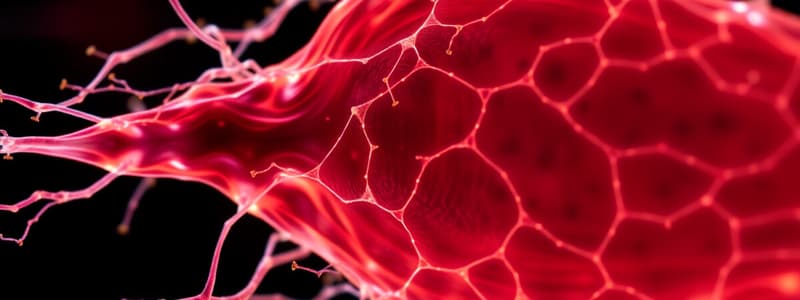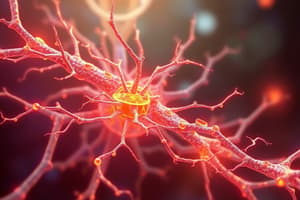Podcast
Questions and Answers
What are the three major types of cytoskeletal proteins?
What are the three major types of cytoskeletal proteins?
- Intermediate filaments, Actin, Mitochondria
- Microfilaments, Intermediate filaments, Microtubules (correct)
- Actin, Tubulin, Collagen
- Microtubules, Ribosomes, Plasmodesmata
How do cytoskeletal proteins alter the shape of cells?
How do cytoskeletal proteins alter the shape of cells?
- By breaking down the ECM components
- By increasing the amount of ATP produced
- By forming additional layers of the plasma membrane
- By changing their length or sliding past one another (correct)
What role do motor proteins play in relation to microfilaments and microtubules?
What role do motor proteins play in relation to microfilaments and microtubules?
- They stabilize the structure of organelles
- They transport organelles along microfilaments and microtubules (correct)
- They assist in the formation of the extracellular matrix
- They provide nutrients to the cytoskeleton
What is the significance of ATP in cytoskeletal function?
What is the significance of ATP in cytoskeletal function?
Which cytoskeletal component is primarily involved in the contraction of muscle cells?
Which cytoskeletal component is primarily involved in the contraction of muscle cells?
What is the main function of intermediate filaments in animal cells?
What is the main function of intermediate filaments in animal cells?
During cell division, what role do microtubules play?
During cell division, what role do microtubules play?
What enables the elongation of microtubules and microfilaments in cell movement?
What enables the elongation of microtubules and microfilaments in cell movement?
What is the main function of the extracellular matrix (ECM) in animal cells?
What is the main function of the extracellular matrix (ECM) in animal cells?
How do the cell walls of plant cells differ from the extracellular matrix in animal cells?
How do the cell walls of plant cells differ from the extracellular matrix in animal cells?
What do growth factors in the extracellular matrix primarily promote?
What do growth factors in the extracellular matrix primarily promote?
What role do plasmodesmata serve in plant cells?
What role do plasmodesmata serve in plant cells?
What is a primary component of the extracellular matrix that aids in its function?
What is a primary component of the extracellular matrix that aids in its function?
Flashcards are hidden until you start studying
Study Notes
Cytoskeleton
- A dynamic network of protein fibers within the cytoplasm, composed of three major types:
- Microfilaments (thin): Made of actin protein.
- Intermediate filaments (medium): Made of various proteins.
- Microtubules (thick): Made of tubulin protein.
- Provides both internal support and the ability for cells to change shape and divide.
- Plays a key role in regulating:
- Cell Shape:
- Cytoskeletal proteins can alter cell shape by changing their length (adding or removing subunits) or by sliding past one another.
- Intermediate filaments provide support, influence shape, and connect cells to each other and the ECM.
- Microfilaments beneath the plasma membrane provide additional support and connect to the ECM.
- Cell Movement:
- Microtubules and microfilaments can extend by adding subunits at one end and releasing them at the other.
- These structures can be associated with motor proteins, which use energy from ATP for movement.
- Actin microfilaments can slide past each other, driven by motor proteins, as seen in muscle contraction.
- Organelle Movement:
- Motor proteins use microfilaments and microtubules as “railroad tracks” to transport organelles within the cell.
- Cell Division:
- Microtubules guide chromosome movements during cell division.
- Microfilaments in animal cells contribute to pinching the dividing cell into two daughter cells.
- Cell Shape:
Plasma Membrane
- Extremely thin (two molecules thick) and fluid
- Requires reinforcing structures for support
Animal Cell Extracellular Matrix (ECM)
- Secreted by the cell
- Composed of proteins and polysaccharides
- Provides structural and biochemical support
- Contains growth factors for cell survival and growth
- Attaches adjacent cells
- Transmits signals between cells
- Guides cell migration and differentiation
- Anchors cells within tissues
- Forms scaffolding for bone and cartilage
Plant Cell Wall
- Provides protection and support
- Composed mainly of cellulose fibers
- Porous, allowing passage of oxygen, carbon dioxide, and water
- Attaches adjacent cells
- Contains plasmodesmata for cytoplasmic connections between cells
Studying That Suits You
Use AI to generate personalized quizzes and flashcards to suit your learning preferences.




